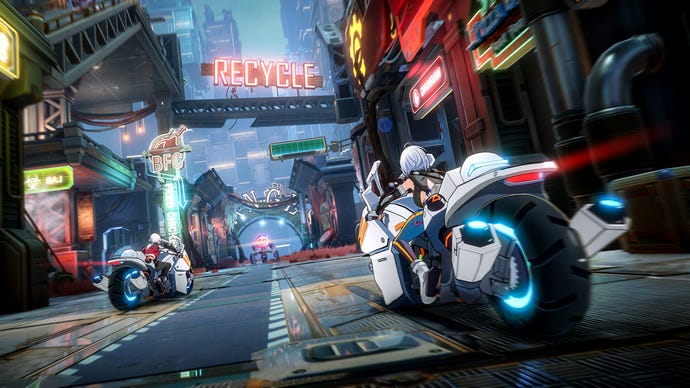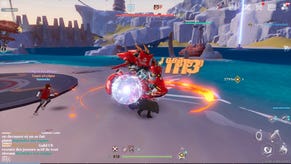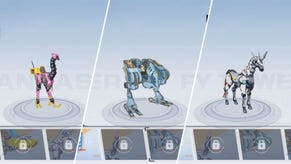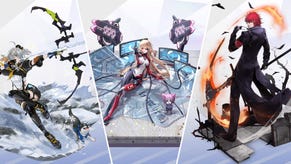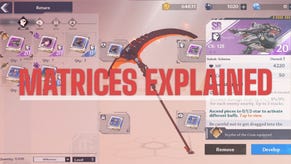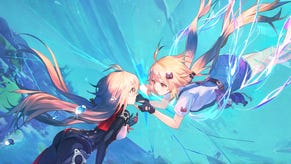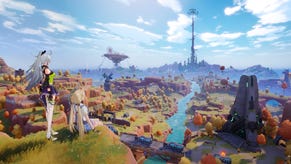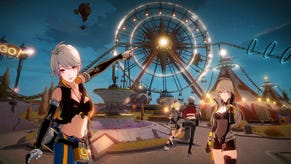Tower of Fantasy review: Genshin Impact’s newest rival will be lucky to survive the winter
Is it worth jumping into Tower of Fantasy?
Tower of Fantasy seemed to ignite in hype and popularity overnight, right? Sure, those invested in this particular brand of RPG may have been aware of its arrival for some time, but who could have expected it to capture so much attention — to become the topic of conversation in gaming spaces. Off the back of this hype, I jumped in eager to see what’s going on among thousands of other like-minded folks.
While initially great, the heat and hype radiating off Tower of Fantasy whittles away quickly. It’s a flashfire, catching your eye at first before smoldering to a quick and disappointing conclusion, burning up your time (and perhaps your wallet) in that fleeting moment.
But what is Tower of Fantasy? First off, it’s not a brand-new game by any means. Released in China some time ago, the action-RPG has now been released globally for both mobile platforms and PC. It falls into the category of ‘ever expanding and ludicrously profitable open world Gacha ARPG’, a genre currently dominated by Genshin Impact in the west and with more and more titles with shared DNA trickling over.
Tower of Fantasy does a wonderful job at immediately snatching your interest with a dynamic and explosive combat system, where even your first sword feels weighted and powerful in the tutorial. The game allocates you three weapon slots in place of party members in traditional RPGs, and these can be freely swapped in the midst of a fight, allowing you to pull out the appropriate tool for the job at will.
If there’s one part of Tower that keeps me playing it really is the process of fighting the rank-and-file enemies spread out in the world. A quick look at each weapon’s combo page will show you it’s not an endurance test of how hard and fast you can mash buttons — there are unique strings that can lead to high-flying strikes and aerial acrobatics that persist in its intensity.
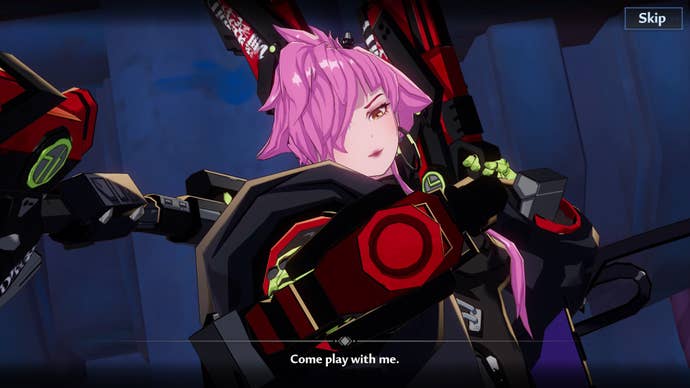
As such, combat has a healthy amount of depth to it. Each weapon has an elemental attribute that enemies will have resistances or weaknesses to, forcing you to pick and choose your active loadout carefully in challenging content. Weapons have abilities and supers attached, often forcing you to swap between them to be efficient. Dodging at the perfect time freezes enemies in place, allowing you to freely heal or cash in free damage. Oh, and don’t forget Relics! Obtainable items that can be equipped and used on-cooldown for powerful effects, these add another part of your kit you need to monitor and squeeze for that extra oomph.
All of these separate components combine to make the process of killing off random enemies out in the world enjoyable, and more powerful foes found out in the world or in instanced group content downright exciting. Don’t get me wrong, this isn’t Devil May Cry 5, but it remains engaging, nonetheless.
But what about the world itself? You’re not just fighting in some white room after all, where do you actually go? Well, the world featured in Tower of Fantasy is a fractured one, split into six regions; each a post-disaster cocktail of wilderness and technological ruin. While the clash of futuristic old world and natural new is featured throughout the entire game, the vibrancy of the game makes the landscape immediately interesting. You’re assailed by bright oranges and deep blues that catch the eye and keep things lively.
Enemies reflect the world around them in a way that really differentiates themselves from other colossal Gacha-ARPGs out there right now. Borderlands-esque gang members called Hyenas roam around with cobbled together armour and weapons, while the mysterious forces of the Heirs of Aria — the main antagonists of the game — have a more refined looks with up-to-date tech and laser swords. There are some real winners in there, like the hunched-over blokes that exist on Raincaller island, walking around with a half-tire on their back as more elite forces native to their turf.
What of the story? It’s a mixed bag. While I usually wouldn’t talk much about the narrative and its twists – no one likes spoilers after all – I can’t see the point when the game has one of the big twists plastered on loading screens, server selection, the official website and, as of writing, the star of the current special event banner. Once you leave the tutorial you meet a girl called Shirli and her brother Zeke who help you out, only for the bubbly Shirli to become infected by Aberrants (basically techno zombies) and doomed to die. Zeke, not liking the idea, instead goes out and teams up with the big bads in order to save her, which kicks off your journey across the world.
This initial narrative is bland and unremarkable. It’s the core string that ties together your journey across the world, but it’s the threads that spin off from it that are far more appealing. There’s a point in the story following your time in Banges that starts to dive into what exactly happened to the world to cause the calamity that is far more appealing — so much so that I was really in the mood to blast my way through it. However, that’s when one of Tower of Fantasy’s most frustrating issues rears its ugly head… time gating!

I hate time gating. If I want to finish work at 5pm and body Tower of Fantasy until 2am, I want the freedom to do that – to mess up my sleep schedule and throw real life sociability out the window in place of progress in a video game. From what I’ve heard, this only gets harder when you hit 30, so I want to do it now. Attempting to do so in Tower of Fantasy will have you slam into a concrete wall, with the words “This Quest will be available in 8 hours” plastered on in bright red letters. As of right now Tower of Fantasy’s narrative isn’t in the game — not in full. You need to come back tomorrow, or the next day, or next week in order to see what happens next.
You might be thinking “go and explore the world! Loot some prizes and unlock some fancy stuff”. Great idea! There are plenty of chests and supply orbs around, which can drop resources or even in-game currency if you find something really good. The game is even quite nice in this regard, giving you exact locations of the real valuable stuff on your minimap from a decent distance away, meaning you don’t spend as much time scrapping the corners of the map as you might expect. In your rootin’ and lootin’ adventure you might even come across a Dream Orb – basically a randomly dropped mini-game that helps mix up the tedium of rushing around and opening boxes. Fun, right?
Except even this is time gated. More often than not, especially at launch, half the boxes you’d come across would be locked for 24 hours, 48 hours, or occasionally even longer! I finished up a puzzle in the Crown Mines and opened up a warehouse with a golden supply pod inside, only to be met with a 48-hour timer until I could claim the reward for my hard work. If you’re keeping up with the game, logging in every day and exploring the highest-level areas available to you, you are punished for doing so. It’s awful.
The reason why this is here is clear, and while I initially tried to think of more optimistic reasons why this was the case, I was wasting my own time in naivety. It’s the gacha, the financial engine that powers not just this game but all games in the genre. If you could sit down over a weekend and beat the story, you might leave content. Instead, sit around and collect login bonuses over a week, come across treasures you can’t access without data chips you could buy, require loot from a joint mission but find yourself lacking the in-game vitality to do it until tomorrow. All of these nudge you to buy, and the longer you find yourself playing the more pressing the urge to drop £4, £10, £20 and more.

Supply pods are locked and story quests are time gated to ensure a drip feed of rewards — fast at first as the game heaps rewards your way in the first few days before closing the tap slowly. Are you 100 dark crystals away from buying the 10 red orbs you need to use on a limited banner that’ll go away in a week? Well, you can’t get them out in the world, so I guess you’ll have to wait. Or… buy them.
If this aspect of the game was in a closed off space, separate from the rest of the game, many could live with it in the background. But the tendrils latch onto each of the game’s major and minor problems in a way that makes it impossible to ignore. Purple super rare characters look okay I suppose, but it’s those golden Super Super rare characters that explode off your screen and pack the coolest looks.
It also makes the game’s difficulty hard to parse. I lucked out big time by pulling King and Samir — two of the game’s most powerful characters as of writing — from banners using currency I earned by scrounging around. This made the early hours of the game, and all of the story content pish easy. This is of course the case, since if you expect players to dump real world money, they deserve to have an easier time, regardless of how that dominoes into wider problems for other players.
Add onto this the slow rising difficulty of group content — something you obviously want to see in games like this to give dedicated players something to do — and the temptation to blow a few quid on rolls is palpable.
I believe the biggest casualty of this is PvP, which as of writing, only consists of a 1v1 arena mode. While stats are neutralised between both players as well as equipment upgrades, each weapon comes with its own move set and attacks. If I, with my scythe, ice greatsword, and Chakram, can create massive AOE fire strikes, Chakram kill boxes and waves of uninterruptible ranged greatsword strikes, what chance does someone who got unlucky and pulled worse, less optimal weapons have? The problem isn’t with the numbers, it’s with the attacks you gain from getting the best and rarest weapons.
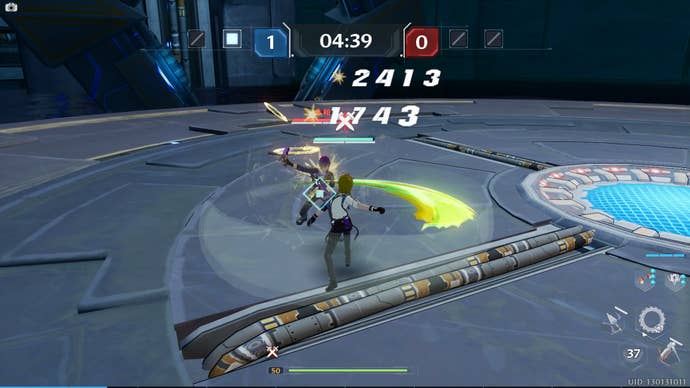
This also has me worried about the future of the game PvP-wise. If strength is tied to weapons and their move set, and a new weapon is released to banners that is top tier, are dedicated players meant to cross their fingers and pray they get the fresh meta gear? Of course not, they're meant to pull out their card and pay for rolls until they get it. There will be a battle royale mode that seemingly will fix this problem, but as of writing this isn’t present in the game so I cannot comment on its strengths or weaknesses. As it stands right now, PvP left me wanting – a mode with standardised weapons would make sense.
It’s hard to ignore something like this when it worms its way into so many aspects of the game. It makes it hard to forgive smaller mistakes and issues that usually would fall under the radar when the game feels like a whale factory rather than a game playable off its own merits. My favourite little mistake in Tower of Fantasy can be found on security keypads, which have the number 9 replaced with “10% off” in what I can only interpret as a reminder of what’s valued most with this title.
At the end of the day, you can have a decent amount of fun with Tower of Fantasy but it’s hard to see this title having much of a future. Just next week, Genshin Impact has its version 3.0 release which will drain most of the content-hungry gacha crowd away, while Zenless Zone Zero appears to be a looming giant that’ll present a post-apocalyptic sci-fi setting with great quality. Investing much time and money doesn’t feel right when the strengths of the title can’t overpower the overwhelming negatives.
The hype around Tower of Fantasy will not survive the winter, it may already be on its way out.
